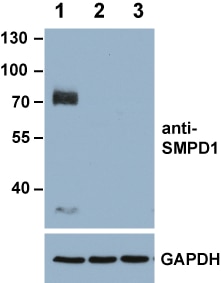Human SMPD1 Antibody Summary
His62-Pro628
Accession # NP_000534
Customers also Viewed
Applications
(Catalog # 5348-PD), see our available Western blot detection antibodies.
Please Note: Optimal dilutions should be determined by each laboratory for each application. General Protocols are available in the Technical Information section on our website.
Preparation and Storage
- 12 months from date of receipt, -20 to -70 °C as supplied.
- 1 month, 2 to 8 °C under sterile conditions after reconstitution.
- 6 months, -20 to -70 °C under sterile conditions after reconstitution.
Background: SMPD1
Sphingomyelin phosphodiesterase, also known as acid sphingomyelinase and encoded by the SMPD1 gene, is a lysosomal phosphodiesterase which belongs to the acid sphingomyelinase family (1). SMPD1 catalyzes the hydrolysis of sphingomyelin to ceramide and phosphorylcholine. Ceramide, a bioactive lipid, has emerged as an important signaling molecule involved in a variety of cellular processes such as cell differentiation, apoptosis, and proliferation (2). Activation of SMPD1 occurs by the removal, chemical modification or dimerization of its C-terminal cysteine residue (3). Deficiencies of SMPD1 result in a lysosomal storage disorder referred to as Niemann-Pick disease (4). rhSMPD1 was expressed without the last three C-terminal residues, and is therefore constitutively active.
- Schuchman, E.H. et al. (1991) J. Biol. Chem. 266:8531.
- Melendez, A.J. et al. (2008) Biochim. Biophys. Acta 1784:66.
- Qiu, H. et al. (2003) J. Biol. Chem. 278:32744.
- Smith, E.L. and Schuchman, E.H. (2008) FASEB J. 22:3419.
Product Datasheets
Citations for Human SMPD1 Antibody
R&D Systems personnel manually curate a database that contains references using R&D Systems products. The data collected includes not only links to publications in PubMed, but also provides information about sample types, species, and experimental conditions.
2
Citations: Showing 1 - 2
Filter your results:
Filter by:
-
Differential regulation of microRNA-15a by radiation affects angiogenesis and tumor growth via modulation of acid sphingomyelinase
Authors: S Rana, C Espinosa-D, R Ruhl, N Chatterjee, C Hudson, E Fraile-Bet, A Agarwal, S Khou, CR Thomas, S Anand
Sci Rep, 2020-03-27;10(1):5581.
Species: Mouse
Sample Types: Cell Culture Lysates
Applications: Western Blot -
Acid Sphingomyelinase regulates the localization and trafficking of palmitoylated proteins
Authors: Xiahui Xiong, Chia-Fang Lee, Wenjing Li, Jiekai Yu, Linyu Zhu, Yongsoon Kim et al.
Biology Open
FAQs
No product specific FAQs exist for this product, however you may
View all Antibody FAQsIsotype Controls
Reconstitution Buffers
Secondary Antibodies
Reviews for Human SMPD1 Antibody
Average Rating: 5 (Based on 1 Review)
Have you used Human SMPD1 Antibody?
Submit a review and receive an Amazon gift card.
$25/€18/£15/$25CAN/¥75 Yuan/¥2500 Yen for a review with an image
$10/€7/£6/$10 CAD/¥70 Yuan/¥1110 Yen for a review without an image
Filter by:
30 micrograms of proteins per lane. Nitrocellulose membrane. 5% milk/PBS-Tween was used for blocking. Antibody dilution: 1:1000 in 1% milk/PBS-Tween. Lane 1=wild-type cells, lane 2 and 3 show two different knock-out clones obtained by CRISPR/Cas9 genome editing.
A loading control (GAPDH) is also shown.


















